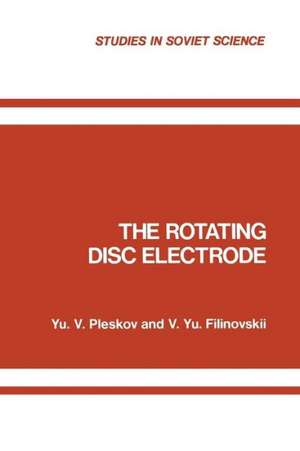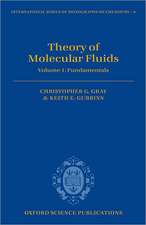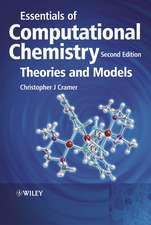The Rotating Disc Electrode: Studies in Soviet Science
Autor Yu. V. Pleskoven Limba Engleză Paperback – 24 apr 2012
Din seria Studies in Soviet Science
-
 Preț: 381.59 lei
Preț: 381.59 lei -
 Preț: 385.47 lei
Preț: 385.47 lei -
 Preț: 385.84 lei
Preț: 385.84 lei -
 Preț: 390.25 lei
Preț: 390.25 lei -
 Preț: 401.61 lei
Preț: 401.61 lei -
 Preț: 382.57 lei
Preț: 382.57 lei -
 Preț: 397.16 lei
Preț: 397.16 lei -
 Preț: 387.75 lei
Preț: 387.75 lei - 5%
 Preț: 362.88 lei
Preț: 362.88 lei -
 Preț: 387.75 lei
Preț: 387.75 lei - 5%
 Preț: 360.70 lei
Preț: 360.70 lei -
 Preț: 389.88 lei
Preț: 389.88 lei -
 Preț: 397.16 lei
Preț: 397.16 lei -
 Preț: 386.81 lei
Preț: 386.81 lei - 5%
 Preț: 366.56 lei
Preț: 366.56 lei - 5%
 Preț: 717.73 lei
Preț: 717.73 lei -
 Preț: 389.49 lei
Preț: 389.49 lei - 18%
 Preț: 726.06 lei
Preț: 726.06 lei - 15%
 Preț: 635.65 lei
Preț: 635.65 lei -
 Preț: 380.45 lei
Preț: 380.45 lei - 5%
 Preț: 363.44 lei
Preț: 363.44 lei - 15%
 Preț: 637.93 lei
Preț: 637.93 lei -
 Preț: 387.96 lei
Preț: 387.96 lei
Preț: 394.29 lei
Nou
Puncte Express: 591
Preț estimativ în valută:
75.45€ • 80.68$ • 62.91£
75.45€ • 80.68$ • 62.91£
Carte tipărită la comandă
Livrare economică 18 aprilie-02 mai
Preluare comenzi: 021 569.72.76
Specificații
ISBN-13: 9781461585633
ISBN-10: 1461585635
Pagini: 424
Ilustrații: XVII, 402 p.
Dimensiuni: 152 x 229 x 22 mm
Greutate: 0.56 kg
Ediția:Softcover reprint of the original 1st ed. 1976
Editura: Springer Us
Colecția Springer
Seriile Studies in Soviet Science, 1976
Locul publicării:New York, NY, United States
ISBN-10: 1461585635
Pagini: 424
Ilustrații: XVII, 402 p.
Dimensiuni: 152 x 229 x 22 mm
Greutate: 0.56 kg
Ediția:Softcover reprint of the original 1st ed. 1976
Editura: Springer Us
Colecția Springer
Seriile Studies in Soviet Science, 1976
Locul publicării:New York, NY, United States
Public țintă
ResearchCuprins
1 Liquid Flow at a Rotating Disc.- §1.1. Basic Equations of Flow of a Viscous Incompressible Liquid.- §1.2. Solution of Equation of Motion for a Viscous, Incompressible Liquid at the Surface of a Rotating Disc.- §1.3. “Similarity” of Hydrodynamic Phenomena.- §1.4. Turbulent Flow.- References.- 2 Convective Diffusion.- §2.1. Basic Equations of Convective Diffusion in a Moving Liquid.- §2.2. Theory of “Similarity” of Mass-Transport Processes.- §2.3. Solution of the Equation of Convective Diffusion to the Surface of a Rotating Disc.- §2.4. Diffusional Flux.- §2.5. Quantitative Verification of the Theory; Laminar Flow.- §2.6. Measurements of Diffusion Coefficients.- §2.7. Concentration Measurements. Analytical Applications of the Rotating Disc Electrode.- §2.8. Approximate Calculation Methods for Convective Diffusion.- §2.9. Diffusion Flux under Turbulent Conditions.- References.- 3 Mixed Kinetics of Heterogeneous Reactions.- §3.1. The Rate of the Heterogeneous Reaction.- §3.2. Basic Equation of Mixed Kinetics.- §3.3. Determination of the Reaction Order and of the Rate Constant.- §3.4. First-Order Reactions.- §3.5. Experimental Determination of the Kinetic Characteristics of an Electrode Reaction.- §3.6. The State of the Electrode Surface and the Transition from Diffusion to Mixed Kinetic Control.- §3.7. Mixed Kinetics of Heterogeneous Reactions at the Surface of a Nonuniform Disc.- References.- 4 Electric Current in a Cell with a Rotating Disc Electrode.- §4.1. General Equations.- §4.2. Electric Current Flow in the Cell.- §4.3. Distribution of the Electric Field and of Ionic Concentrations in the Vicinity of the Electrode.- §4.4. Distribution of the Electric Field and of Ionic Concentrations in the Double-Layer Region.- §4.5. VoltammetricCurves.- §4.6. The Limiting Current.- §4.7. The Rotating Disc Electrode in Solutions of a Binary Electrolyte.- §4.8. The Rotating Disc Electrode in a Solution Containing an Excess of Inert Electrolyte 154.- §4.9. Voltammetric Characteristics of the Cell in the Case of a Redox Reaction.- §4.10. The Ohmic Potential Drop in the Cell.- References.- 5 Nonstationary Processes at the Rotating Disc Electrode.- §5.1. General Comments on Nonstationary Diffusion.- §5.2. Equations for Nonstationary Convective Diffusion.- §5.3. Establishment of a Stationary Regime for the Given Surface Concentration of the Transferred Species.- §5.4. Establishment of a Stationary Regime at a Given Density of Diffiisional Flux (Relaxation of Potential upon Switching on Constant Current). 182 §5.5. Establishment of a Stationary Current for an Irreversible Electrode Reaction.- §5.6. Polarization of the Electrode with Potentials Varying in Time: General Equations.- §5.7. Polarization of the Electrode with a Linear Potential Sweep. The Case of a Reversible.- Reaction.- §5.8. Polarization of an Electrode with a Periodically Oscillating Potential.- §5.9. Autooscillating Processes.- References.- 6 Studies of Chemical Reactions in a Bulk Phase (Kinetic and Catalytic Currents).- §6.1. General Method of Calculation of Kinetic Currents at the Rotating Disc Electrode.- §6.2. Preceding Chemical Reaction.- §6.3. Catalytic Processes.- §6.4. The Effect of Chemical Reactions Following the Electrochemical Processes.- §6.5. Investigation of Chemical Reactions of Electrochemically Inactive Species.- References.- 7 Application of the Rotating Disc Electrode to Various Electrochemical Problems.- §7.1. Separation of Two Simultaneous Electrode Processes.- §7.2. Study of the Type of Polarization inMetal Deposition.- §7.3. Anodic Metal Dissolution and Electropolishing.- §7.4. Corrosion of Metals. Dissolution of Nonmetals.- §7.5. The Rotating Disc in Systems with Variable Physical Properties.- §7.6. Thermal Diffusion near the Surface of a Rotating Disc.- References.- 8 Rotating Ring-Disc Electrode.- §8.1. Calculation of the Current at the Ring Electrode.- §8.2. Quantitative Verification of the Theory.- §8.3. Application of the Rotating Ring-Disc Electrode to Mechanistic and Kinetic Studies of Multistep Electrode Reactions (Theory).- §8.4. Experimental Studies of Oxygen Reduction.- §8.5. Determination of Reaction Orders of Separate Stages of an Electrochemical Process.- §8.6. Voltammetric Curve at the Ring.- §8.7. Kinetic Currents and Nonstationary Processes.- §8.8. Application of the Ring-Disc Assembly to Studies of Anodic Dissolution, Corrosion and Passivation of Metals, and Electrode Reactions Involving Organic and Inorganic Compounds.- References.- 9 Design of the Rotating Disc Assembly.- §9.1. The Disc Electrode.- §9.2. Drive Mechanism; Measurements of Rotation Speed.- §9.3. Electrochemical Cell.- References.- Appendix 1. Articles on the Rotating Disc Electrode.- Appendix 2. Supplementary References.











